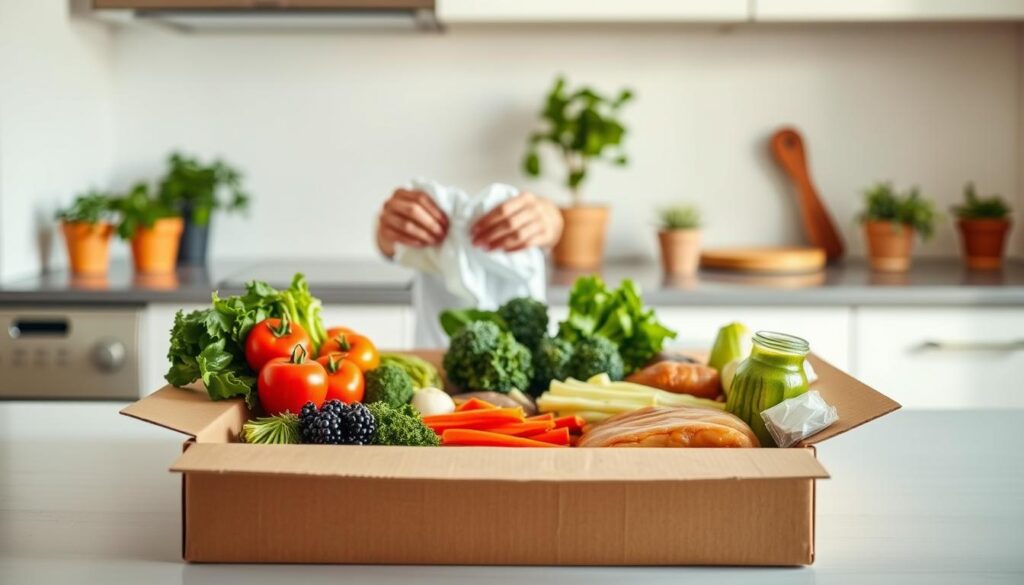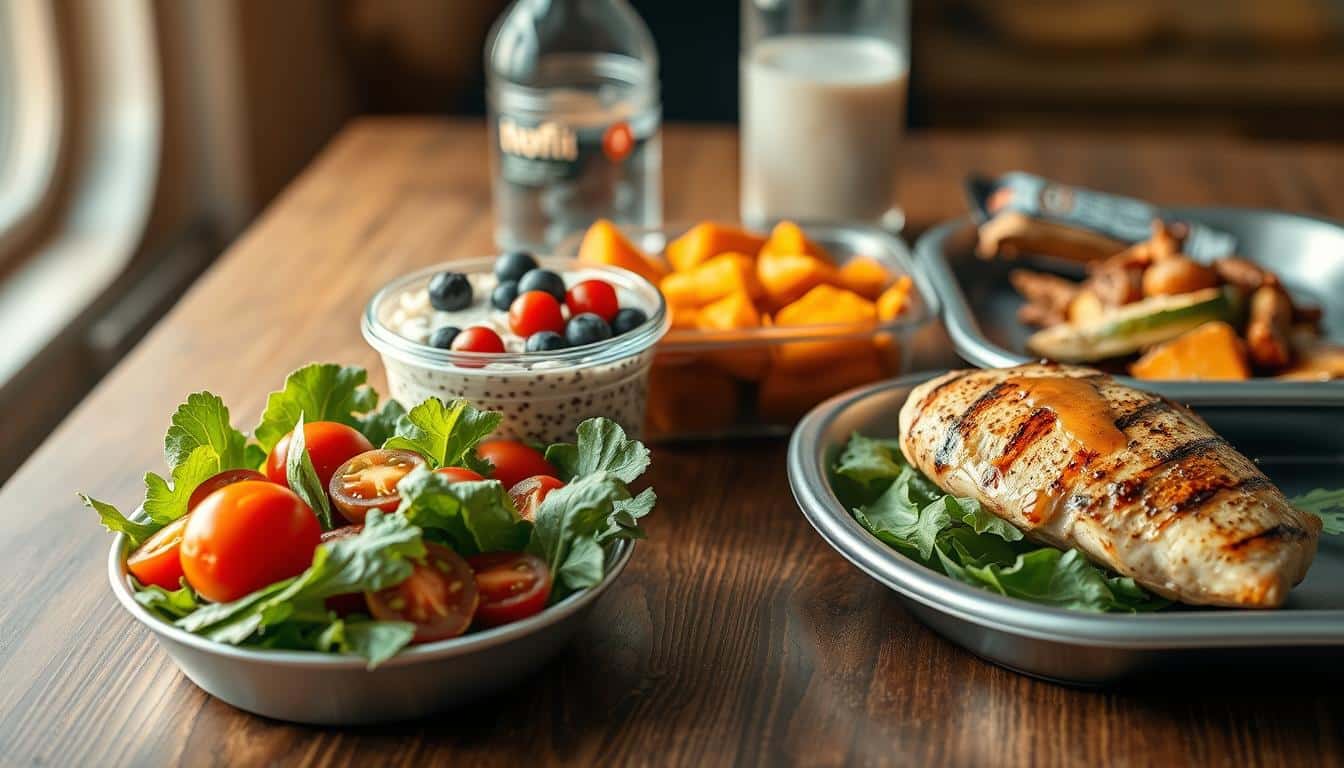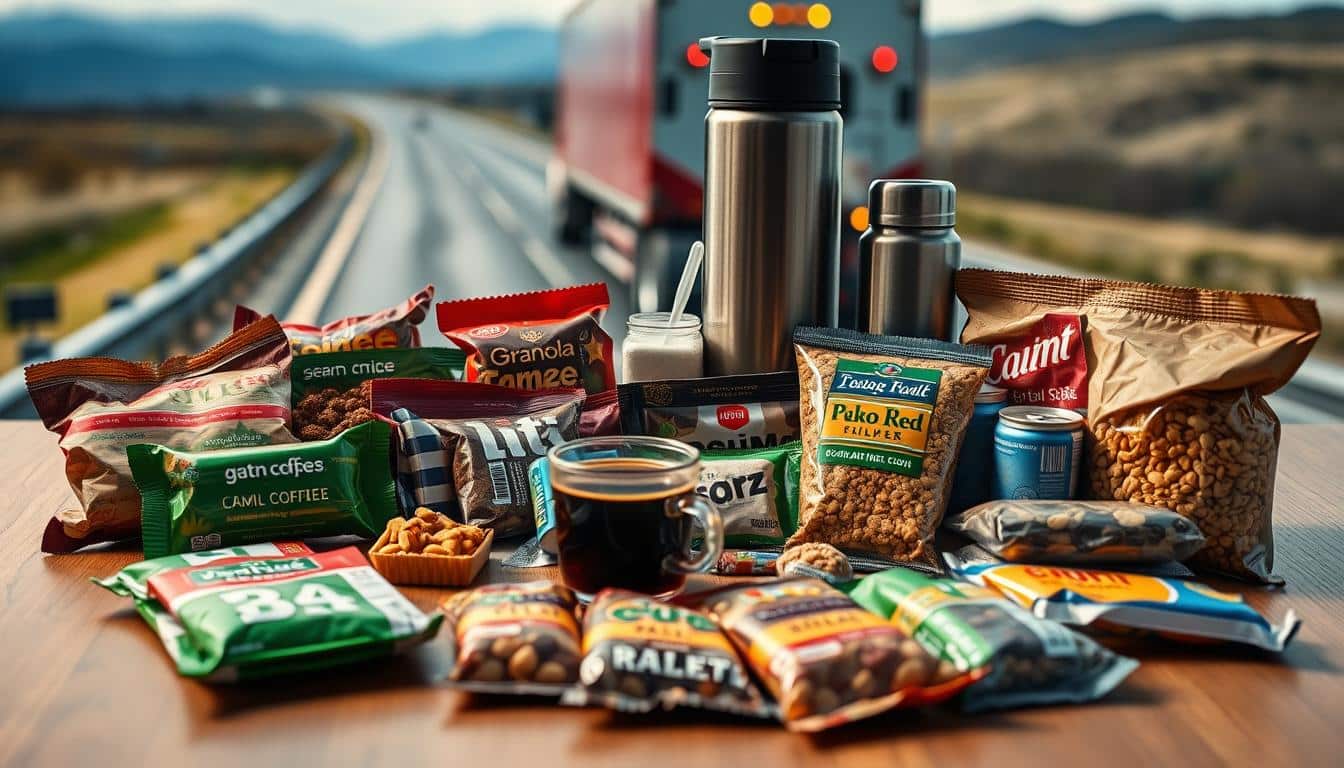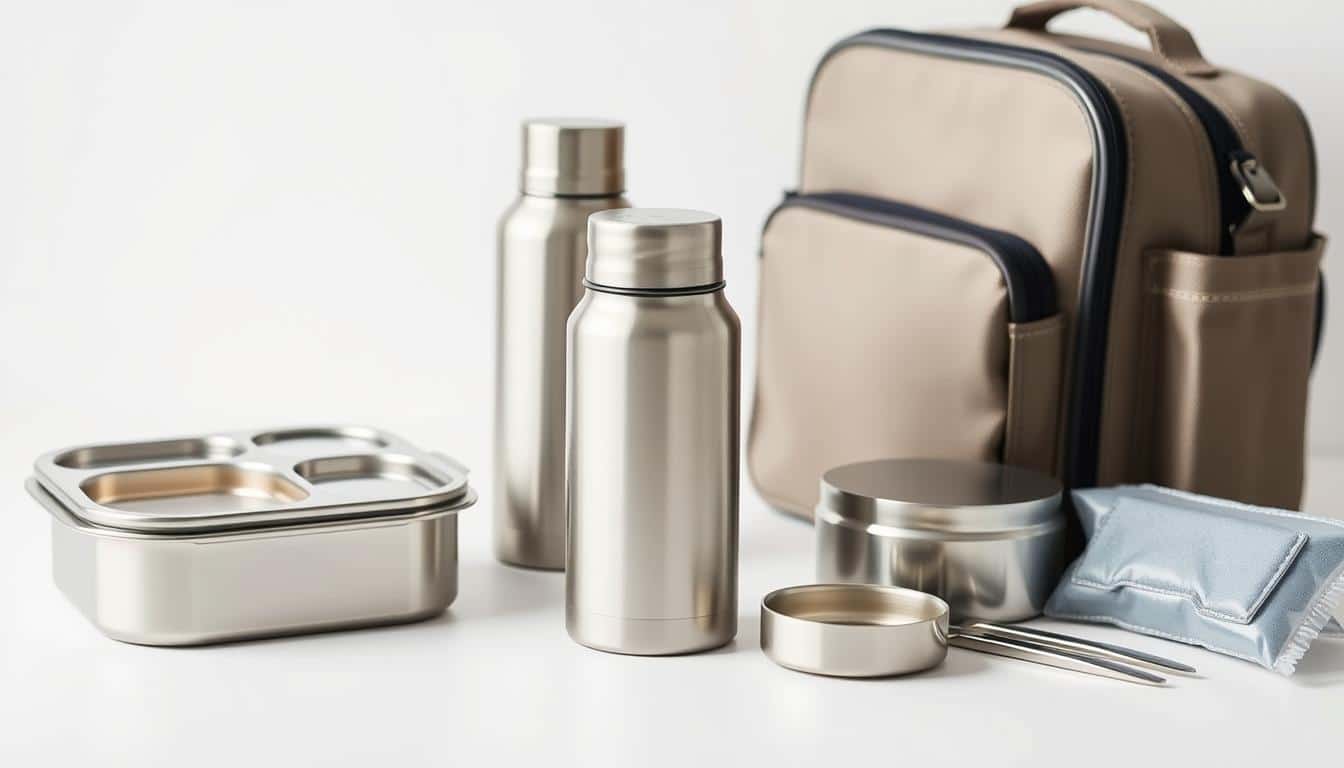Meal planning can be hard after a busy day. Meal kits make cooking easy. They offer healthy dinners that are quick to make and delicious.
Services like Sunbasket and Green Chef focus on healthy eating. They provide meals that are rich in veggies but still taste great. Home Chef and Mosaic offer meals that are easy to cook. These meal plans also let you make changes based on what you like.
Meal kits are popular because they save time. They give you fast, nutritious meals without needing to buy lots of groceries. Whether you pick Factor’s ready meals or Purple Carrot’s vegan options, meal subscriptions help make dinner time better and healthier.
Why Efficient meal kits are a game-changer for healthy eating
Meal kits structure our weekly meal planning. Companies like Sunbasket and Home Chef remove the stress of figuring out what to cook and buy. This helps choose veggie-heavy meals easily on busy evenings, keeping our meals diverse.
Meal kits are a big help when we’re swamped. With options like Home Chef, meals come together in 30 minutes or less. Factor offers meals that just need heating, saving lots of time for busy folks.
These kits also teach us portion control. They come with just the right amount of ingredients and clear instructions. This way, every meal has the right amount of food, keeping our diets consistent.
Meal kits mean less food waste. With just the right amount of ingredients from services like Home Chef, we don’t buy more than we need. Brands like Hungryroot blend shopping with cooking, streamlining what we buy.
- Fast options: Express recipes and ready-made meals cut evening meal time.
- Balanced portions: Pre-measured ingredients encourage steady portions and nutrition.
- Less waste: Smaller ingredient packs and targeted deliveries help reduce food waste.
Meal kits bring a bunch of benefits for those looking to eat healthier with less fuss. They tackle convenience, quick prep, right-sized meals, and cutting down on waste, all in one weekly routine.
How meal kits support balanced, produce-forward meals
Meal kits simplify creating complete meals without extra effort. They often use a basic pattern: a protein, vegetables, and a starch. This helps improve the nutrition and satisfaction of meals made at home.
Services like Sunbasket and Factor focus on meals rich in vegetables. They send meals with lots of veggies, like kale salads or butternut stews. Green Chef and Sunbasket make it easy to eat more vegetables with pre-portioned veggies and ready-made parts.
Daily Harvest, Purple Carrot, and Mosaic emphasize vegetables and plant proteins in their menus. ModifyHealth offers meals with lean proteins and green veggies for specific health needs. These services demonstrate that meal kits can cater to various tastes and nutritional requirements.
- Typical meal plate composition: roughly half vegetables, a quarter protein, a quarter starch or grain.
- Pre-portioned produce and clear labeling make serving sizes obvious.
- Premade sauces and stocks reduce barriers to adding more veggies.
Brands like Factor and Pete’s offer ready-to-eat meals following the same nutritious pattern. Home Chef uses badges such as Fresh Start and Carb-Conscious to help customers choose balanced meals. These indicators make it simpler to pick meals that help increase vegetable consumption.
Choosing the right healthy meal kit for your diet goals
Start by figuring out what health goals you have. It’s crucial to use filters and read labels carefully. Meal kit services make it easy to sort by diet, cooking time, and ingredient quality. Consider how much cooking you’re up for, if you need to track macros, and if organic food matters to you.
Look for meal kits that fit your diet, like vegan, keto, paleo, or low-FODMAP. Green Chef and Sunbasket have great options for Paleo and Keto diets. For those who eat plant-based, Purple Carrot and Mosaic are top picks. ModifyHealth is good for low-FODMAP diets and includes dietitian support.
Before choosing a meal kit, check for added sugars, sodium, and calories. Reviews will help you spot kits with high sugar or sodium. Home Chef makes it easy to find meals that are low in sugar and sodium with special labels.
- When to choose pre-made: pick Factor, Pete’s, or Mosaic for speed, fixed macros, or intense training weeks.
- When to choose kit-style: pick Sunbasket, Green Chef, or Home Chef for hands-on cooking, cost control, and fresh-ingredient variety.
- For strict diets: use services with dietitian input or clear allergen filters to avoid cross-contact risks.
Decide if you prefer the ease of ready-to-heat meals or the adventure of cooking yourself. Keto meal kits are great for those watching carbs. Vegan kits offer lots of veggies and support a plant-based diet. Choose low-FODMAP meals with a doctor’s advice if you have a sensitive stomach.
Try a week’s meals from a couple of services before settling. It lets you compare sizes, tastes, and ingredients. This way, you can find a meal plan that fits your time, money, and health needs best.
Top meal kit features that signal quality and health
When choosing a meal kit, look for clear quality indicators. Good services list where their ingredients come from, how much you get, and nutrition facts. These details help customers pick meals that fit their health needs and budget.
Organic and sustainably sourced ingredients
Choosing certified organic matters for less pesticide use and safer ingredients. Green Chef boasts a lot of certified-organic veggies and meats. Sunbasket tries to use organic produce whenever possible.
It’s good to pick meal deliveries that focus on sustainable sourcing, especially for seafood and meat. Brands that share where their ingredients come from or their certifications make it easy to see their effect on the planet and animals.
Clear nutritional labeling and portion sizes
Meal kits should show nutrition details like calories, fats, carbs, and salt for each serving. Factor and Home Chef offer detailed nutrition info for every meal, helping those on specific diets or with health concerns.
Having the right amount of ingredients cuts down on guessing and wasting food. When recipes give exact amounts, it’s easier to switch up parts of the meal or change the size safely.
Recipe transparency and chef-tested instructions
Knowing exactly what’s in a recipe helps cooks feel more confident. With step-by-step directions, accurate cooking times, and pictures, mistakes are less likely. Home Chef’s Customize It feature and clear instructions allow for personalized meals without losing quality.
Recipes tested by chefs ensure dishes turn out well every time. Services that offer details about their ingredients, nutritional facts, and tips for swaps give a perfect mix of deliciousness and reliability.
Meal kit service comparisons: what testing reveals
Hands-on testing shows there are big differences in how meal kits handle packing, how long prep takes, and the taste. Testers look at how easy boxes are to open, how well cold items stay cold, and if the ingredients are organized by meal or just tossed in. These factors affect how fast you can make your meal and keep ingredients fresh.
Unboxing and packaging: keeping ingredients fresh
Testers pay attention to the unboxing of meal kits. They check if ingredients are pre-measured and separated by meal. For example, Sunbasket and Green Chef are often noted for their good packaging with insulated liners. Home Chef also does a good job with its insulated boxes and clear recipe cards.
Cold chain integrity is crucial, especially for seafood and leafy greens. Without proper insulation or ice packs, produce wilts quickly. Reviews note how well packing is done and mention any item swaps, like organic items being replaced.
Recipe accuracy and real cook times vs. advertised times
Comparisons often include how long meals take to cook versus what’s advertised. Test kitchens show recipes typically take 5–15 minutes longer. Knowing the real time helps in planning meals.
Some options, like Home Chef’s Oven-Ready meals, need less active cooking time. Services like Factor offer prepared meals that are just reheated, which changes how prep time is evaluated.
Taste, texture, and meal balance across brands
Taste tests of meal delivery services show differences in flavor and texture. Meals from Factor and Pete’s often get high marks for right portion size and consistent taste. Sakara and Purple Carrot are liked for their creative meals, although their prices differ.
Some frozen or microwaved meals can make vegetables soggy or taste the same. But companies like Mosaic and Daily Harvest keep their produce crisp. Testers look for meals that are both appealing and have a good mix of textures and flavors.
- What to watch during testing: packaging layout, ice pack placement, and ingredient separation.
- Timing checks: compare advertised minutes with stopwatch results to gauge meal kit cook time accuracy.
- Flavor checks: run controlled taste tests meal delivery samples to assess balance and texture.
Cost and value: are meal kits worth it?
Is a subscription worth it? Think about the cost of the meal kit compared to the time it saves, how it cuts down on waste, and the quality of food. Meal kits might cost more than buying ingredients yourself. However, services like Sunbasket and Green Chef offer organic and chef-crafted options that add value. For those hectic evenings, options like Factor or Pete’s tilt the scale towards convenience.

It’s smart to look at prices before deciding. Blue Apron’s dishes range from $8 to $12 per serving. Green Chef’s offerings are about $13 each plate, while Purple Carrot prices float between $11 and $13.25. Home Chef starts at $7.99, but most meals are around $9.99. Remember, shipping costs and deals can change the total cost quickly.
Save money by being strategic. Look for deals like first-box discounts, ways to get free shipping, and points for sticking with them. By combining these discounts and special offers, the price can be close to what you’d pay at the store for certain meals.
- Don’t forget to consider how meal kits save you time prepping and reduce food thrown out.
- Combining meal kits with ready-to-eat meals can keep your food budget in check without boring your taste buds.
- Keep an eye out for deals that lower the price per meal on large or family plans.
Meal kits are more like a tool, not just another bill. Use them to mix up dinner during busy weeks or when you need a change. Tight on cash? Buy basic ingredients at the market and save meal kits for those times you’re short on time or energy. This balanced approach can make meal kits an affordable option that still brings convenience and healthy food to your table.
Healthy prepared meals vs. DIY meal kits
Choosing between cooked meals or meal kits depends on your time, objectives, and taste preferences. Prepared meals offer quick nutrition and convenience. Meal kits allow you to try cooking and get fresher food. Mixing both can suit busy lifestyles and healthy eating goals well.
Pros and cons of heat-and-eat services like Factor and Pete’s
- Factor offers microwavable meals with clear nutritional info. It suits athletes needing exact portion sizes for their diets.
- Pete’s Real Food has high-quality meats and big portions. It is great for those on gluten-free or high-protein diets.
- With heat-and-eat meals, you might miss out on crunch and could get watery veggies. These services trade cooking freshness for time-saving and consistency.
When prepared meals fit nutrition or training goals
Prepared meals are great for busy training times or travel. They make it easy to know your calorie and nutrient intake. Athletes with tight schedules find them helpful for meeting protein needs and recovery times.
Meals with clear nutrition labels help manage your diet whether you’re losing weight, building muscle, or just maintaining. Plant-based or wellness-focused options offer convenient choices from companies like Mosaic and Daily Harvest.
How to mix prepared meals with DIY cooking for variety
- Use ready meals on your busiest days to keep eating well. Keep meal kits for leisurely cooking on weekends or with friends.
- Try a Home Chef Oven-Ready meal with a salad on the side for better taste and more veggies.
- Change up your meals to avoid getting bored. Try new sides or spruce up dishes with fresh herbs or citrus.
- Athletes can match a ready-made main dish with a quick, kit-prepped side for both ease and rich nutrition.
Combining meal kits with prepared meals makes food prep versatile. It helps save time, meet your fitness goals, and keep cooking fun, all without the daily hassle.
Meal kit brands to consider for specific needs
Choosing a meal kit depends on what’s important to you: diverse options, organic food, or vegan choices. We’ve outlined brief profiles to suit various preferences. This way, you can find a service that aligns with your evening routine, budget, and health goals.
-
Best for variety and produce-forward menus:
Sunbasket is known for its wide selection, offering 15–20 recipes plus extra items. It focuses on dishes rich in vegetables and has options for paleo, gluten-free, and high-protein diets. Most ingredients are organic, but some non-organic items might be used. Cooking times may be longer than expected.
-
Best organic-certified option:
Green Chef was the first meal kit with CCOF organic certification. It provides top-notch meats, seafood, and vegetables. The instructions are straightforward. New users get nutrition coaching with their initial order. Sometimes, the recipes might seem repetitive and out-of-season veggies may be included.
-
Best plant-based and vegan options:
Purple Carrot is all about vegan meals and ready-to-eat options. Its recipes are unique and tasty but might cost a bit more. For the best results, follow the steps carefully.
Mosaic is celebrated for meals that taste like they’re from a restaurant and include crisp vegetables. It offers large, budget-friendly prepared meals perfect for busy families who want plant-based convenience.
Also worth mentioning are Factor, for protein-rich ready meals, and Pete’s Real Food, for organic choices aimed at athletes. Daily Harvest offers frozen veggie bowls and smoothies, and ModifyHealth has low-FODMAP plans with dietitian support. Hungryroot combines grocery items with recipes. Look for the brand that matches your dietary needs and how much time you can dedicate.
Practical tips for getting the most from your meal kit subscription
Meal kits can easily fit into your busy schedule with a few smart habits. Use the menu filters and customization options to cater to your dietary needs. This can also make dinner prep quicker. At delivery, take a few steps to ensure freshness and minimize waste.

How to filter menus and customize protein swaps
Begin by filtering recipes for your diet, like paleo or gluten-free, similar to what Sunbasket offers. Avoid ingredients you dislike or can’t have to make the menus fit your needs better.
Try Home Chef’s Customize It or Blue Apron for protein swaps. This not only saves cooking time but also helps with portion control.
Unboxing routine to speed up weeknight cooking
Get into a steady routine with your meal kit unboxing. Start by opening the box on a clean surface. First, look through the recipe cards. Then, organize the ingredients by recipe into labeled groups.
- Immediately store meats and dairy in the fridge.
- Identify any premade components to cut down prep time.
- Allow extra time for cooking than the guide suggests and plan your evening.
Storing leftovers and reheating without losing quality
Keep leftovers tasting good by refrigerating them in sealed containers within two hours. Mark the containers with the date to help you keep track.
When warming up leftovers, choose the oven or stovetop for the best texture. Microwaves work for quick heating but keep an eye on dishes with lots of veggies to avoid mushiness.
These tips enhance your meal kit experience. From selecting kits to reheating leftovers, small changes mean tastier dinners and less fuss.
Nutrition expert guidance for evaluating meal kits
Dietitians give easy advice to help meal kits fit your diet. They say to read labels, watch portion sizes, and choose kits that meet your health goals. Taking these steps when ordering can prevent unexpected issues at mealtime.
Sodium checks and label reading advice from RDNs
Lauren Manaker, a diet expert, warns about the sodium in meal kits. She mentions that sauces and pre-made parts can make sodium levels too high.
She advises to always check the sodium per serving on the label. This helps to avoid meals with too much hidden salt in sauces and spice mixes.
How to assess real vegetable portion sizes
Dietitians suggest aiming for a half-cup of cooked vegetables per meal as a guide. But, meal kits usually list veggies by weight, which can be confusing.
To make sure you’re getting enough veggies, measure them after cooking at first. If a meal kit is lacking, simply add extra veggies like a salad or steamed greens.
Using meal kits to meet macro or specialty nutrition needs
Some meal services, like Factor and Pete’s, make it easy to track protein and calories. Choose meals that help meet your fitness and weight loss goals using their macro info.
- For specific nutrition needs, consider getting advice from dietitians through services like ModifyHealth. They offer plans for managing diabetes, celiac disease, and more.
- Pick meal kits that offer flexible options, like swapping proteins or adding sides. This lets you adjust macros without extra work.
- Look at the nutrition details provided by Home Chef and Green Chef. This helps manage intake of sodium, sugar, and calories throughout your week.
By following dietitian advice and carefully reading labels, you can make smarter choices. Keeping track of veggies and macros in meal kits can make convenient eating healthier.
Sustainability and packaging concerns with meal kits
Meal kits offer easy dinners and fresh ingredients. Yet, their packaging and sourcing concern eco-aware buyers. Recipes are separated clearly to cut waste and spoilage. Sunbasket and Green Chef focus on organic and sustainably sourced options, though changes sometimes happen. Blue Apron is known for recyclable packaging. Home Chef uses insulated boxes with gel packs to keep food fresh.
Reducing plastic use starts with simple steps. Brands offer guides on recycling. Remember to clean and flatten cardboard and follow your area’s recycling rules. Unpacking boxes quickly, flattening them, and rinsing out containers can help. Many services guide you on recycling or returning items.
Companies work on being more eco-friendly in different ways. Sunbasket and Green Chef prefer organic and ethically raised meats. Blue Apron works on recyclable packaging for the stuff inside. Daily Harvest avoids spoilage by shipping frozen goods, affecting the packaging materials.
To reduce waste with meal kits, organize your fridge. Label everything. Freeze stuff you won’t eat soon. Many meals freeze well. Try to reuse cold packs or drop them at recycling spots.
- Look at recycling info that comes with each kit.
- Eat fresh veggies early in the week.
- Get kits less often to need less packaging and lower emissions.
Both shoppers and companies can make meal kits greener. Choosing brands with clear eco-friendly policies can reduce waste. And opting for services with good sustainability practices won’t make you sacrifice convenience.
Conclusion
Meal kits simplify making tasty meals during busy weeknights. Brands like Sunbasket focus on varied, fresh meals. Green Chef offers organic options. Purple Carrot provides plant-based dishes, and Factor is great for quick, ready-to-heat meals. These options help you try new recipes, eat more veggies, and cut down on grocery shopping and planning time.
Picking the right meal kit depends on your budget, dietary needs, and how involved you want to be in cooking. Kits that you cook yourself offer fresh tastes and the chance to learn. Fully prepared meals are better for quick eating and specific nutrition goals. Watch out for hidden sodium, sugar, and the real cost per meal, including delivery fees. Always check the meal’s nutrition facts and ingredients to see if they fit your diet.
In the US, services like Home Chef let you customize your meals and take advantage of deals. You can mix ready-made and cook-yourself kits for different tastes. Be smart about unpacking, and store leftovers the right way to avoid wasting food. If you choose carefully and keep an eye on nutrition labels, meal kits can make eating healthier easier.
FAQ
What makes efficient meal kits a good option for healthy eating?
How do meal kits save time for busy Americans?
Do meal kits help with consistent portion control and balanced nutrition?
Can meal kits increase my vegetable servings?
Which services are best for produce-forward, balanced meals?
What diet filters should I look for when choosing a meal kit?
How should I evaluate sodium, sugar, and calorie content?
When should I choose pre-made meals instead of kit-style recipes?
What meal kit features signal higher quality and healthier choices?
How reliable are cook times and recipe accuracy?
How do unboxing and packaging affect meal quality?
Are meal kits more expensive than grocery shopping or takeout?
How can I get the best value from meal kit subscriptions?
What are the pros and cons of heat-and-eat services like Factor and Pete’s?
How can I combine prepared meals with DIY kits for variety?
Which brands are recommended for specific needs like organic or plant-based?
How do I customize meals or swap proteins to meet my needs?
What is the best unboxing routine to speed up weeknight cooking?
How should I store leftovers and reheat without losing quality?
What nutrition expert tips should I follow when evaluating meal kits?
How can I assess true vegetable portion sizes in meal kits?
What sustainability and packaging concerns should I consider?
Which brands are making progress on sustainable sourcing and packaging?
How can I minimize waste when using meal kits at home?
Content created with the help of Artificial Intelligence.



